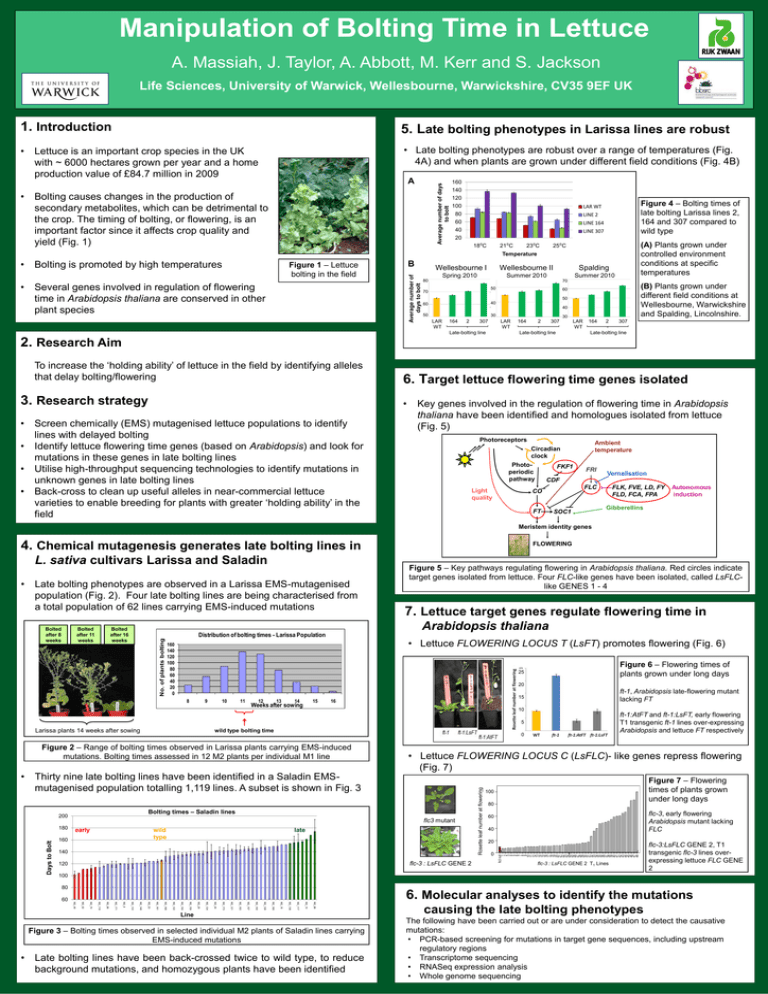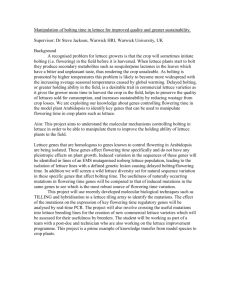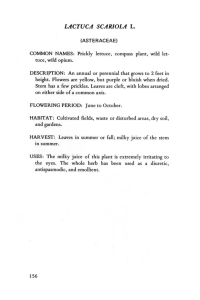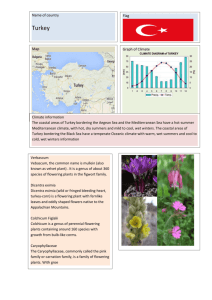Manipulation of Bolting Time in Lettuce 1. 5. L
advertisement

Manipulation of Bolting Time in Lettuce A. Massiah, J. Taylor, A. Abbott, M. Kerr and S. Jackson Life Sciences, University of Warwick, Wellesbourne, Warwickshire, CV35 9EF UK 1. Introduction 5. Late bolting phenotypes in Larissa lines are robust • • Late bolting phenotypes are robust over a range of temperatures (Fig. 4A) and when plants are grown under different field conditions (Fig. 4B) A Average number of days to bolt • Lettuce is an important crop species in the UK with ~ 6000 hectares grown per year and a home production value of £84.7 million in 2009 Bolting causes changes in the production of secondary metabolites, which can be detrimental to the crop. The timing of bolting, or flowering, is an important factor since it affects crop quality and yield (Fig. 1) 160 140 120 100 80 60 LAR WT 40 20 LINE 307 Figure 4 – Bolting times of late bolting Larissa lines 2, 164 and 307 compared to wild type LINE 2 LINE 164 18⁰C 21⁰C 23⁰C (A) Plants grown under controlled environment conditions at specific temperatures 25⁰C Temperature • Figure 1 – Lettuce bolting in the field Bolting is promoted by high temperatures B Average number of days to bolt • Several genes involved in regulation of flowering time in Arabidopsis thaliana are conserved in other plant species Wellesbourne I Wellesbourne II Spalding Spring 2010 Summer 2010 Summer 2010 80 70 50 70 (B) Plants grown under different field conditions at Wellesbourne, Warwickshire and Spalding, Lincolnshire. 60 50 60 40 50 30 40 LAR WT 164 2 307 30 LAR WT Late-bolting line 164 2 307 LAR WT Late-bolting line 164 2 307 Late-bolting line 2. Research Aim To increase the ‘holding ability’ of lettuce in the field by identifying alleles that delay bolting/flowering 3. Research strategy • • • • 6. Target lettuce flowering time genes isolated • Screen chemically (EMS) mutagenised lettuce populations to identify lines with delayed bolting Identify lettuce flowering time genes (based on Arabidopsis) and look for mutations in these genes in late bolting lines Utilise high-throughput sequencing technologies to identify mutations in unknown genes in late bolting lines Back-cross to clean up useful alleles in near-commercial lettuce varieties to enable breeding for plants with greater ‘holding ability’ in the field Key genes involved in the regulation of flowering time in Arabidopsis thaliana have been identified and homologues isolated from lettuce (Fig. 5) Photoreceptors Ambient temperature Circadian clock Photoperiodic pathway Light quality FKF1 FRI Vernalisation CDF FLC CO FT SOC1 FLK, FVE, LD, FY FLD, FCA, FPA Autonomous induction Gibberellins Meristem identity genes 4. Chemical mutagenesis generates late bolting lines in L. sativa cultivars Larissa and Saladin Late bolting phenotypes are observed in a Larissa EMS-mutagenised population (Fig. 2). Four late bolting lines are being characterised from a total population of 62 lines carrying EMS-induced mutations Bolted after 8 weeks Bolted after 11 weeks Figure 5 – Key pathways regulating flowering in Arabidopsis thaliana. Red circles indicate target genes isolated from lettuce. Four FLC-like genes have been isolated, called LsFLClike GENES 1 - 4 7. Lettuce target genes regulate flowering time in Arabidopsis thaliana Bolted after 16 weeks Distribution of bolting times - Larissa Population No. of plants bolting • FLOWERING • Lettuce FLOWERING LOCUS T (LsFT) promotes flowering (Fig. 6) 160 140 120 100 80 60 40 20 0 Figure 6 – Flowering times of plants grown under long days 25 20 8 9 10 11 12 13 14 15 Weeks after sowing ft-1, Arabidopsis late-flowering mutant lacking FT 15 16 10 ft-1:AtFT and ft-1:LsFT, early flowering T1 transgenic ft-1 lines over-expressing Arabidopsis and lettuce FT respectively 5 wild type bolting time 0 • GENE 2 Thirty nine late bolting lines have been identified in a Saladin EMSmutagenised population totalling 1,119 lines. A subset is shown in Fig. 3 Bolting times – Saladin lines 200 Days to Bolt 180 flc3 mutant early wild type 160 late 140 flc-3 : LsFLC GENE 2 120 100 100 A 80 80 flc-3, early flowering Arabidopsis mutant lacking FLC 60 60 40 40 20 20 0 0 Figure 7 – Flowering times of plants grown under long days flc-3 : LsFLC GENE 2 T1 Lines Line flc-3:LsFLC GENE 2, T1 transgenic flc-3 lines overexpressing lettuce FLC GENE 2 100 80 6. Molecular analyses to identify the mutations M2_88 M2_10 M2_117 M2_138 M2_18 M2_169 M2_126 M2_100 M2_157 M2_183 M2_121 M2_173 M2_44 M2_124 M2_29 M2_159 M2_150 M2_122 M2_168 M2_161 M2_53 M2_148 M2_133 M2_8 M2_171 M2_86 M2_118 M2_70 M2_52 M2_49 60 Line Figure 3 – Bolting times observed in selected individual M2 plants of Saladin lines carrying EMS-induced mutations • • Lettuce FLOWERING LOCUS C (LsFLC)- like genes repress flowering (Fig. 7) Roseteleaf leafnumber number at flowering flowering Rosette Figure 2 – Range of bolting times observed in Larissa plants carrying EMS-induced mutations. Bolting times assessed in 12 M2 plants per individual M1 line flc3 null 1 2 3 4 5 6 7 8 9 10 11 12 13 14 15 16 17 18 19 20 21 22 23 24 25 26 27 28 29 30 31 32 33 34 35 36 37 38 39 40 41 42 43 44 45 46 47 48 Larissa plants 14 weeks after sowing Late bolting lines have been back-crossed twice to wild type, to reduce background mutations, and homozygous plants have been identified causing the late bolting phenotypes The following have been carried out or are under consideration to detect the causative mutations: • PCR-based screening for mutations in target gene sequences, including upstream regulatory regions • Transcriptome sequencing • RNASeq expression analysis • Whole genome sequencing






